Capybara
The capybara (Hydrochoerus hydrochaeris) is a giant cavy rodent native to South America. It is the largest living rodent in the world.[2] Also called capivara (in Brazil), chigüire, chigüiro (in Colombia and Venezuela), carpincho (in Argentina, Paraguay and Uruguay) and ronsoco (in Peru), it is a member of the genus Hydrochoerus, of which the only other extant member is the lesser capybara (Hydrochoerus isthmius). Its close relatives include guinea pigs and rock cavies, and it is more distantly related to the agouti, the chinchilla, and the coypu. The capybara inhabits savannas and dense forests and lives near bodies of water. It is a highly social species and can be found in groups as large as 100 individuals, but usually lives in groups of 10–20 individuals. The capybara is not a threatened species, but it is hunted for its meat and hide and also for grease from its thick fatty skin.[3]
| Capybara | |
|---|---|
| Scientific classification | |
| Kingdom: | Animalia |
| Phylum: | Chordata |
| Class: | Mammalia |
| Order: | Rodentia |
| Family: | Caviidae |
| Genus: | Hydrochoerus |
| Species: | H. hydrochaeris |
| Binomial name | |
| Hydrochoerus hydrochaeris (Linnaeus, 1766) | |
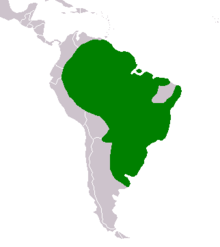 | |
| Native range | |
| Synonyms | |
|
Sus hydrochaeris Linnaeus, 1766 | |
Etymology
Its common name is derived from Tupi ka'apiûara, a complex agglutination of kaá (leaf) + píi (slender) + ú (eat) + ara (a suffix for agent nouns), meaning "one who eats slender leaves", or "grass-eater".[4] Capybaras were called several times "Cuartins" in Colombia in 2018: in Eje Cafetero (Alcalà) and near Barranquilla where the meat was offered as "Cuartin Asado".
The scientific name, both hydrochoerus and hydrochaeris, comes from Greek ὕδωρ (hydor "water") and χοῖρος (choiros "pig, hog").[5][6]
Classification and phylogeny
The capybara and the lesser capybara belong to the subfamily Hydrochoerinae along with the rock cavies. The living capybaras and their extinct relatives were previously classified in their own family Hydrochoeridae.[7] Since 2002, molecular phylogenetic studies have recognized a close relationship between Hydrochoerus and Kerodon, the rock cavies,[8] supporting placement of both genera in a subfamily of Caviidae.[5]
Paleontological classifications previously used Hydrochoeridae for all capybaras, while using Hydrochoerinae for the living genus and its closest fossil relatives, such as Neochoerus[9][10], but more recently have adopted the classification of Hydrochoerinae within Caviidae.[11] The taxonomy of fossil hydrochoerines is also in a state of flux. In recent years, the diversity of fossil hydrochoerines has been substantially reduced.[9][10] This is largely due to the recognition that capybara molar teeth show strong variation in shape over the life of an individual.[9] In one instance, material once referred to four genera and seven species on the basis of differences in molar shape is now thought to represent differently aged individuals of a single species, Cardiatherium paranense.[9] Among fossil species, the name "capybara" can refer to the many species of Hydrochoerinae that are more closely related to the modern Hydrochoerus than to the "cardiomyine" rodents like Cardiomys.[11] The fossil genera Cardiatherium, Phugatherium, Hydrochoeropsis, and Neochoerus are all capybaras under that concept.
Description
.jpg)
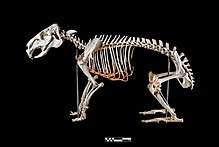
The capybara has a heavy, barrel-shaped body and short head, with reddish-brown fur on the upper part of its body that turns yellowish-brown underneath. Its sweat glands can be found in the surface of the hairy portions of its skin, an unusual trait among rodents.[7] The animal lacks down hair, and its guard hair differs little from over hair.[12]
Adult capybaras grow to 106 to 134 cm (3.48 to 4.40 ft) in length, stand 50 to 62 cm (20 to 24 in) tall at the withers, and typically weigh 35 to 66 kg (77 to 146 lb), with an average in the Venezuelan llanos of 48.9 kg (108 lb).[13][14][15] Females are slightly heavier than males. The top recorded weights are 91 kg (201 lb) for a wild female from Brazil and 73.5 kg (162 lb) for a wild male from Uruguay.[7][16] Also, an 81 kg individual was reported in São Paulo in 2001 or 2002.[17] The dental formula is 1.0.1.31.0.1.3.[7] Capybaras have slightly webbed feet and vestigial tails.[7] Their hind legs are slightly longer than their forelegs; they have three toes on their rear feet and four toes on their front feet.[18] Their muzzles are blunt, with nostrils, and the eyes and ears are near the top of their heads.
Ecology
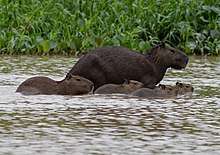
Capybaras are semiaquatic mammals[15] found throughout almost all countries of South America except Chile.[19] They live in densely forested areas near bodies of water, such as lakes, rivers, swamps, ponds, and marshes,[14] as well as flooded savannah and along rivers in the tropical rainforest. They are superb swimmers and can hold their breath underwater for up to five minutes at a time.[20] Capybara have flourished in cattle ranches.[7] They roam in home ranges averaging 10 hectares (25 acres) in high-density populations.[7]
Many escapees from captivity can also be found in similar watery habitats around the world. Sightings are fairly common in Florida, although a breeding population has not yet been confirmed.[21] In 2011, one specimen was spotted on the Central Coast of California.[22]
Diet and predation
_on_Capybara.jpg)
Capybaras are herbivores, grazing mainly on grasses and aquatic plants,[14][23] as well as fruit and tree bark.[15] They are very selective feeders[24] and feed on the leaves of one species and disregard other species surrounding it. They eat a greater variety of plants during the dry season, as fewer plants are available. While they eat grass during the wet season, they have to switch to more abundant reeds during the dry season.[25] Plants that capybaras eat during the summer lose their nutritional value in the winter, so are not consumed at that time.[24] The capybara's jaw hinge is not perpendicular, so they chew food by grinding back-and-forth rather than side-to-side.[26] Capybaras are autocoprophagous, meaning they eat their own feces as a source of bacterial gut flora, to help digest the cellulose in the grass that forms their normal diet, and to extract the maximum protein and vitamins from their food. They may also regurgitate food to masticate again, similar to cud-chewing by cattle.[27] As is the case with other rodents, the front teeth of capybaras grow continually to compensate for the constant wear from eating grasses;[19] their cheek teeth also grow continuously.[26]
Like its relative the guinea pig, the capybara does not have the capacity to synthesize vitamin C, and capybaras not supplemented with vitamin C in captivity have been reported to develop gum disease as a sign of scurvy.[28]
They can have a lifespan of 8–10 years,[29] but live less than four years in the wild, because they are "a favourite food of jaguar, puma, ocelot, eagle, and caiman".[19] The capybara is also the preferred prey of the anaconda.[30]
Social organization
Capybaras are known to be gregarious. While they sometimes live solitarily, they are more commonly found in groups of around 10–20 individuals, with two to four adult males, four to seven adult females, and the remainder juveniles.[31] Capybara groups can consist of as many as 50 or 100 individuals during the dry season[27][32] when the animals gather around available water sources. Males establish social bonds, dominance, or general group consensus.[32] They can make dog-like barks[27] when threatened or when females are herding young.[33]
Capybaras have two types of scent glands; a morrillo, located on the snout, and anal glands.[34] Both sexes have these glands, but males have much larger morrillos and use their anal glands more frequently. The anal glands of males are also lined with detachable hairs. A crystalline form of scent secretion is coated on these hairs and is released when in contact with objects such as plants. These hairs have a longer-lasting scent mark and are tasted by other capybaras. Capybaras scent-mark by rubbing their morrillos on objects, or by walking over scrub and marking it with their anal glands. Capybaras can spread their scent further by urinating; however, females usually mark without urinating and scent-mark less frequently than males overall. Females mark more often during the wet season when they are in estrus. In addition to objects, males also scent-mark females.[34]
Reproduction
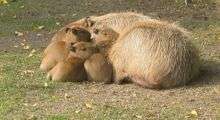
When in estrus, the female's scent changes subtly and nearby males begin pursuit.[35] In addition, a female alerts males she is in estrus by whistling through her nose.[27] During mating, the female has the advantage and mating choice. Capybaras mate only in water, and if a female does not want to mate with a certain male, she either submerges or leaves the water.[27][32] Dominant males are highly protective of the females, but they usually cannot prevent some of the subordinates from copulating.[35] The larger the group, the harder it is for the male to watch all the females. Dominant males secure significantly more matings than each subordinate, but subordinate males, as a class, are responsible for more matings than each dominant male.[35] The lifespan of the capybara's sperm is longer than that of other rodents.[36]
.jpg)
Capybara gestation is 130–150 days, and produces a litter of four capybaras young on average, but may produce between one and eight in a single litter.[7] Birth is on land and the female rejoins the group within a few hours of delivering the newborn capybaras, which join the group as soon as they are mobile. Within a week, the young can eat grass, but continue to suckle—from any female in the group—until weaned around 16 weeks. The young form a group within the main group.[19] Alloparenting has been observed in this species.[32] Breeding peaks between April and May in Venezuela and between October and November in Mato Grosso, Brazil.[7]
Activities
Though quite agile on land, capybaras are equally at home in the water. They are excellent swimmers, and can remain completely submerged for up to five minutes,[14] an ability they use to evade predators. Capybaras can sleep in water, keeping only their noses out of the water. As temperatures increase during the day, they wallow in water and then graze during the late afternoon and early evening.[7] They also spend time wallowing in mud.[18] They rest around midnight and then continue to graze before dawn.
Conservation and human interaction
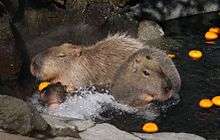
Capybaras are not considered a threatened species;[1] their population is stable throughout most of their South American range, though in some areas hunting has reduced their numbers.[14][19]
Capybaras are hunted for their meat and pelts in some areas,[37] and otherwise killed by humans who see their grazing as competition for livestock. In some areas, they are farmed, which has the effect of ensuring the wetland habitats are protected. Their survival is aided by their ability to breed rapidly.[19]
Capybaras have adapted well to urbanization in South America. They can be found in many areas in zoos and parks,[26] and may live for 12 years in captivity, more than double their natural lifespan.[19] Capybaras are docile and usually allow humans to pet and hand-feed them, but physical contact is normally discouraged, as their ticks can be vectors to Rocky Mountain spotted fever.[38]
The European Association of Zoos and Aquaria asked Drusillas Park in Alfriston, Sussex, England to keep the studbook for capybaras, to monitor captive populations in Europe. The studbook includes information about all births, deaths and movements of capybaras, as well as how they are related.[39]
Capybaras are farmed for meat and skins in South America.[40] The meat is considered unsuitable to eat in some areas, while in other areas it is considered an important source of protein.[7] In parts of South America, especially in Venezuela, capybara meat is popular during Lent and Holy Week as the Catholic Church previously issued special dispensation to allow it to be eaten while other meats are generally forbidden.[41] There is widespread perception in Venezuela that consumption of capybaras is exclusive to rural people.
Although it is illegal in some states,[42] capybaras are occasionally kept as pets in the United States.[43]
The image of a capybara features on the 2-peso coin of Uruguay.[44]
In Japan, following the lead of Izu Shaboten Park in 1982,[45] multiple establishments or zoos in Japan that raise capybaras have adopted the practice of having them relax in onsen during the winter. They are seen as an attraction by Japanese people.[45] Capybaras became big in Japan due to the popular cartoon character Kapibara-san.[46]
Brazilian Lyme-like borreliosis likely involves capybaras as reservoirs and Amblyomma and Rhipicephalus ticks as vectors.[47]
See also
- Josephoartigasia monesi, an extinct species identified as the largest rodent ever
- Kurloff cell, a type of cell found in capybaras and guinea pigs
References
- Reid, F. (2016). "Hydrochoerus hydrochaeris". IUCN Red List of Threatened Species. 2016: e.T10300A22190005. doi:10.2305/IUCN.UK.2016-2.RLTS.T10300A22190005.en. Retrieved 1 May 2017.
- Basic Biology (2015). "Rodents".
- Capybara (Hydrochoerus hydrochaeris) Archived 2012-01-03 at the Wayback Machine. ARKive.org
- Ferreira, A. B. H. (1986) Novo Dicionário da Língua Portuguesa, 2nd ed., Rio de Janeiro: Nova Fronteira, p.344
- Woods, C.A.; Kilpatrick, C.W. (2005). "Infraorder Hystricognathi". In Wilson, D.E.; Reeder, D.M (eds.). Mammal Species of the World: A Taxonomic and Geographic Reference (3rd ed.). Johns Hopkins University Press. p. 1556. ISBN 978-0-8018-8221-0. OCLC 62265494.
- Darwin, Charles R. (1839). Narrative of the surveying voyages of His Majesty's Ships Adventure and Beagle between the years 1826 and 1836, describing their examination of the southern shores of South America, and the Beagle's circumnavigation of the globe. Journal and remarks. 1832–1836. London: Henry Colburn. p. 619.
- In page 57, Darwin says "The largest gnawing animal in the world, the Hydrochærus Capybara (the water-hog), is here also common."
- See it also in The Complete Work of Charles Darwin Online
- Mones, Alvaro; Ojasti, Juhani (16 June 1986). "Hydrochoerus hydrochaeris". Mammalian Species (264): 1–7. doi:10.2307/3503784. JSTOR 3503784.
- Rowe, Diane L.; Honeycutt, Rodney L. (March 2002). "Phylogenetic Relationships, Ecological Correlates, and Molecular Evolution Within the Cavioidea (Mammalia, Rodentia)". Molecular Biology and Evolution. 19 (3): 263–277. doi:10.1093/oxfordjournals.molbev.a004080. PMID 11861886.
- Vucetich, María G.; Deschamps, Cecilia M.; Olivares, Itatí; Dozo, María T. (2005). "Capybaras, size, shape, and time: A model kit". Acta Palaeontologica Polonica. 50 (2): 259–272.
- Deschamps, Cecilia M.; Olivares, Itatí; Vieytes, Emma Carolina; Vucetich, María Guiomar (12 September 2007). "Ontogeny and diversity of the oldest capybaras (Rodentia: Hydrochoeridae; late Miocene of Argentina)". Journal of Vertebrate Paleontology. 27 (3): 683–692. doi:10.1671/0272-4634(2007)27[683:oadoto]2.0.co;2. JSTOR 30126368.
- Cerdeño, E.; Pérez, M.E.; Deschamps, C.M.; Contreras, V.H. (2019). "A new capybara from the late Miocene of San Juan Province, Argentina, and its phylogenetic implications". Acta Palaeontologica Polonica. 64 (1): 199–212. doi:10.4202/app.00544.2018.
- "The Cabybara – 10 Facts About the World's Largest Rodent". WorldAtlas. Retrieved 2020-03-18.
- Capybara Archived 2012-01-03 at the Wayback Machine, Arkive
- Capybara Facts. Smithsonian National Zoological Park. Retrieved on December 16, 2007.
- Capybara. Palm Beach Zoo. Retrieved on December 17, 2007.
- World Association of Zoos and Aquariums. WAZA. Retrieved on 2011-12-07.
- Ferraz, Katia Maria Paschoaletto Micchi de Barros; Bonach, Kelly; Verdade, Luciano Martins (2005). "Relationship between body mass and body length in capybaras (Hydrochoerus hydrochaeris)". Biota Neotropica. 5 (1): 197–200. doi:10.1590/S1676-06032005000100020.
- "Capybara Printout". Enchantedlearning.com. Retrieved 2013-05-27.
- Bristol Zoo Gardens (UK) ''Capybara'' Archived 2007-09-18 at the Wayback Machine. Bristolzoo.org.uk. Retrieved on 2011-12-07.
- "Capybara – Description, Habitat, Image, Diet, and Interesting Facts". Animals Network. 3 August 2018. Retrieved 2019-01-01.
- "Nonnatives – Capybara". myfwc.com.
- Mather, Kate (18 August 2011). "A gnawing question answered: It's a capybara roaming Paso Robles". Los Angeles Times. Retrieved 10 January 2012.
- Forero-Montaña, Jimena; Betancur, Julio; Cavelier, Jaime (June 2003). "Dieta del capibara Hydrochaeris hydrochaeris (Rodentia: Hydrochaeridae) en Caño Limón, Arauca, Colombia" [Distribution and abundance of Caiman crocodilus in the Caño Negro National Wild Life Refuge, Costa Rica]. Revista de Biología Tropical (in Spanish). 51 (2): 571–578. PMID 15162749.
- Quintana, R.D.; Monge, S.; Malvárez, A.I. (1998). "Feeding patterns of capybara Hydrochaeris hydrochaeris (Rodentia, Hydrochaeridae) and cattle in the non-insular area of the Lower Delta of the Paraná River, Argentina". Mammalia. 62 (1). doi:10.1515/mamm.1998.62.1.37.
- Barreto, Guillermo R.; Herrera, Emilio A. (1998). "Foraging patterns of capybaras in a seasonally flooded savanna of Venezuela". Journal of Tropical Ecology. 14 (1): 87–98. doi:10.1017/S0266467498000078. JSTOR 2559868.
- Capybara. Hydrochaeris hydrochaeris. San Francisco Zoo
- Lord, Rexford D. (March 1994). "A descriptive account of capybara behaviour". Studies on Neotropical Fauna and Environment. 29 (1): 11–22. doi:10.1080/01650529409360912.
- Cueto, Gerardo Ruben; Allekotte, Roman; Kravetz, Fernando Osvaldo (January 2000). "Scurvy in capybaras bred in captivity in Argentine". Journal of Wildlife Diseases. 36 (1): 97–101. doi:10.7589/0090-3558-36.1.97.
- Burton M and Burton R. (2002) The International Wildlife Encyclopedia. Marshall Cavendish, ISBN 0-7614-7269-X, p. 384
- Capybara, the master of the grasses: pest or prey Sounds and Colours. Retrieved on January 23, 2011.
- Alho, Cleber J.R.; Rondon, Nelson L. (1987). "Habitats, population densities, and social structure of capybaras (Hydrochaeris Hydrochaeris, Rodentia) in the Pantanal, Brazil". Revista Brasileira de Zoologia. 4 (2): 139–149. doi:10.1590/s0101-81751987000200006.
- Macdonald, D. W. (July 1981). "Dwindling resources and the social behaviour of Capybaras, (Hydrochoerus hydrochaeris) (Mammalia)". Journal of Zoology. 194 (3): 371–391. doi:10.1111/j.1469-7998.1981.tb04588.x.
- Murphey, Robert M.; Mariano, Jorge S.; Moura Duarte, Francisco A. (May 1985). "Behavioral observations in a capybara colony (Hydrochoerus hydrochaeris)". Applied Animal Behaviour Science. 14 (1): 89–98. doi:10.1016/0168-1591(85)90040-1.
- Macdonald, D. W.; Krantz, K.; Aplin, R. T. (March 1984). "Behavioral anatomical and chemical aspects of scent marking among Capybaras (Hydrochaeris hypdrochaeris) (Rodentia: Caviomorpha)". Journal of Zoology. 202 (3): 341–360. doi:10.1111/j.1469-7998.1984.tb05087.x.
- Herrera, Emilio A.; MacDonald, David W. (1993). "Aggression, dominance, and mating success among capybara males (Hydrochaeris hypdrochaeris)". Behavioral Ecology. 4 (2): 114. doi:10.1093/beheco/4.2.114.
- Paula, T.A.R.; Chiarini-Garcia, H.; França, L.R. (June 1999). "Seminiferous epithelium cycle and its duration in capybaras (Hydrochoerus hydrochaeris)". Tissue and Cell. 31 (3): 327–334. doi:10.1054/tice.1999.0039. PMID 10481304.
- Thompson, Andy (January 18, 2008) Trip to South America gives new meaning to outdoors life. Richmond Times.
- "Febre maculosa: "Os médicos no Brasil não conhecem a doença" [Rocky Mountain spotted fever: Brazilian doctors unaware of the disease] (in Portuguese). drauziovarella.com.br. 12 April 2011. Retrieved 2015-08-13.
- "Conservation at Drusillas Park". Drusillas.co.uk. Retrieved 2013-05-27.
- "Capybara, Hydrochoerus hydrochaeris". San Diego Zoo. October 2008. Archived from the original on 30 September 2011. Retrieved 22 June 2011.
- Ellsworth, Brian (March 24, 2005). "In Days Before Easter, Venezuelans Tuck Into Rodent-Related Delicacy". New York Sun.
- "Capybaras as Pets". capybarafacts.com. Retrieved 2014-10-23.
- Perez, Larry (2012). Snake in the Grass: an Everglades Invasion (1st ed.). Sarasota, Fla.: Pineapple Press. p. 89. ISBN 9781561645138.
- "2 Pesos Uruguayos de 2014" (in Spanish). Monedas Uruguay. Retrieved 8 June 2016.
- "Izu Shaboten Animal Park (Ito) – 2018 All You Need to Know Before You Go (with Photos) – TripAdvisor". www.tripadvisor.com.
- Basile, Roberta Carvalho; Yoshinari, Natalino Hajime; Mantovani, Elenice; Bonoldi, Virgínia Nazário; Macoris, Delphim da Graça; Queiroz-Neto, Antonio de (4 October 2016). "Brazilian borreliosis with special emphasis on humans and horses". Brazilian Journal of Microbiology. 48 (1): 167–172. doi:10.1016/j.bjm.2016.09.005. PMC 5220628. PMID 27769883.
External links
| Wikimedia Commons has media related to Hydrochoeris_hydrochaeris. |
| Wikisource has the text of the 1911 Encyclopædia Britannica article Capybara. |
- Alan Taylor (29 Nov 2018). "Companionable Capybaras (18 Photos)". The Atlantic.


- Animal Diversity Web Hydrochoerus hydrochaeris
- Capybara information
